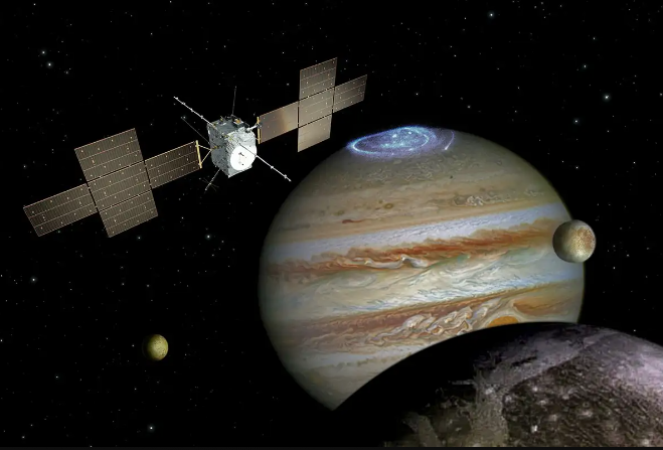
USA: The JUICE (Jupiter Icy Moons Explorer) mission has been delayed by the European Space Agency (ESA) because of unfavourable weather. Less than ten minutes before the scheduled liftoff, it was decided to cancel.
The organisation is now planning to launch the significant mission on April 14 despite the possibility of a lightning strike. Jupiter and its three moons will be investigated by the JUICE mission.
The JUICE mission is now anticipated to launch on April 14 at 5:44 IST. Ariane 5 rockets, which were also used to launch the James Webb Space Telescope in December 2021, will be used to carry out the mission's launch.
Also Read: Amazon has joined the race for generative AI
It will launch from the European Spaceport in Kourou, French Guiana, on the continent of South America's northeastern coast.
Three of Jupiter's moons—Europa, Callisto, and Ganymede—will be thoroughly investigated by the JUICE mission. In a looping orbit, the spacecraft will pass the three Jovian moons and collect data while avoiding the planet's radiation belt. The mission will scan the Jovian system for magnetic signals and other hints that can help confirm the size and presence of subsurface oceans.
JUICE will need the gravitational assistance of Venus, Mars, and Earth to enter Jupiter's orbit, which will take about eight years. The spacecraft will spend three years orbiting Jupiter after arriving there in December 2031. In a phased manner, it will conduct close flybys of three of the Jovian moons.
Ganymede, the largest planet in our solar system and even larger than Mercury, would be the primary subject of study for JUICE. It's interesting to note that it is the only known moon in the solar system with a magnetic field of its own. Perhaps, like the Earth, it has a liquid iron core. In December 2034, JUICE is planned to orbit this Jovian moon.
Also Read: Elon Musk considers AI, censorship, and blue tick
JUICE, which will orbit a moon in the outer solar system for the first time, is equipped to give detailed views of Ganymede.
Starting at about 4,990 kilometres above the surface of the moon, the spacecraft will descend to 480 kilometres by 2035, and possibly even lower if fuel is available.
It will also determine how salty the deep oceans are.
According to Michele Dougherty of Imperial College London, "you need liquid water, a heat source, and organic materials for habitability." "We've done what we said we would do if we confirm or deny those three things."
Europa will likely be the Jovian moon that offers the best chance of finding extraterrestrial life. Because of the hydrothermal vents that erupt upward, scientists think that the ocean on the moon is in direct contact with a rocky floor, which may provide a source of food and energy for life. Two flybys of Europa will be made by the JUICE mission.
Also Read: The live caller ID feature has now been added to True Caller's update for iOS users
Callisto is the second-largest moon of Jupiter, but there is no evidence that life exists there.
The moon has an aged, crater-filled surface. Additionally, it seems to lack a solid core that would contain the nutrients necessary to support life in an ocean.
There are scheduled to be 21 flybys of Callisto by the JUICE spacecraft.